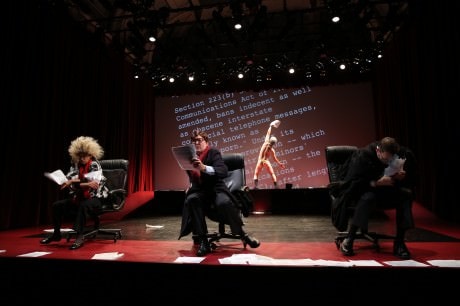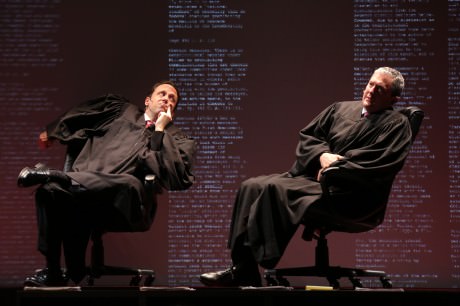“How does one draw a line between Salome and the Kitty Kat Lounge?” A quote from Justice Antonin Scalia made famous during the Supreme Court case of Barnes vs. Glen Theatre. Exploring the case, where a group of go-go dancers challenged a state ban on public nudity, Elevator Repair Service— an innovative theatre company based in New York City— brings their newest show, Arguendo to Woolly Mammoth Theatre Company. I was fortunate enough to have the opportunity to sit down with the company’s Artistic Director, John Collins, and pick his brain about the show itself and what goals the company is striving to achieve with this edgy new work.

Amanda: Please introduce yourself to our readers.
John: My name is John Collins and I am the Artistic Director of Elevator Repair Service Theatre and I am the Director of Arguendo. ERS is a company based out of New York City.
Arguendo is a show that you created with the company in NYC that you’ve now brought down here. What was the draw to want to bring the piece down to Woolly Mammoth?
We premiered the show in New York this past fall at The Public Theatre, but it had been in development since early 2012. It’s a relatively new piece; it’s our current finished piece. This is the fifth engagement that this production it’s had.
There’s an obvious answer to your question. The play is a verbatim recreation of the oral argument of the Supreme Court case, and here in Washington DC you have the Supreme Court. There are a lot of reasons that it is exciting for us to do this show here in Washington. In fact, I’m actually a little bit nervous about who might show up to see it. But we’re actually very excited for those reasons too. Just based on the show’s content it feels very much at home here.
On the other hand, though, we’ve been talking to Woolly Mammoth for years about trying to find someone we could collaborate on. So in that sense, our being here and bringing a show here is longer in the making than the show itself has been. It seemed like a great match; this show and Woolly Mammoth.
How do you feel that Arguendo overall fits into Season 34: ‘America’s Tell-Tale Heart?’
Arguendo is a narrative about American culture in a sense. A lot of what gets debated in this case is the relationship of high culture and low culture. Maybe the dirty little secret here, or at least the question is whether or not this kind of ‘low culture arts’ the strip club performances, whether or not they deserve the same kind of protection of the kinds of creative expression that we maybe are more proud of as a nation.
But here the Supreme Court is actually forced to grapple with question of whether or not, in an idealistic constitutional way, whether or not we want to have ownership of this part of our culture. This then begs the question, do we get to pick and choose which parts of our culture we claim ownership of, and if we do, how do we decide where to draw that line? Justice Scalia brings that up very early in the argument. I think he says, “How do we draw that line between Salome and the Kitty Kat Lounge?”
And that is the question. It’s an interesting fact about oral argument. You may think you’re getting a good indication of where the Justice stands on the case but in this one they can be pretty deceptive. In the end Justice Scalia writes a concurring opinion saying, “that this sort of taking your clothes off doesn’t deserve any kind of constitutional protection.” He’s arguing on the grounds— and here we start getting into the weeds— but he points out the law bans nudity not a particular type of dancing. So he doesn’t think that the first amendment should apply at all to this. But he does ask some really poignant questions about how we make distinctions between something that is more ‘high culture’ like an opera, which is something that we as Americans are more eager to identify with verses this notion of ‘low culture’ and going to the strip club. If there is nudity in the opera, presumably we’re going to the opera for some other reason beside the fact that there happens to be nudity in it, but if we’re going just to see the nudity that’s not good. There are all kinds of different angles from which you can approach this and it makes for a really fascinating conversation.
It raises questions about our culture in so far as we define ourselves politically— and I mean that in the broadest sense of how we define ourselves through this founding document, the Constitution. There is a lot of weight to the understanding of our identity as Americans via this document that supposedly brings us all together. This is a kind of interesting inversion of ways of seeing ourselves as Americans.
You mentioned that this play is a direct verbatim transcript of the court case and you’ve thrown actors into retelling the transcript.
We may have done a little more with it than just adding some actors. Our primary source was actually an audio recording of the oral argument. Even though it’s fairly well known what it looks like in the Supreme Court we decided to take that as a cue to do something more imaginative with the visuals. We have the oral argument, and we have it exactly as it was spoken. We weren’t just studying the written argument here. We have it down to everything including the stutters, and the inflections. Justice White clearing his throat over and over again; that’s all in there.
On top of that we layer on a completely re-imagined visual scenographic idea. We have only three actors playing all nine justices so they’re switching roles a lot. They are constantly moving; we make it an almost type of dance piece layered on top of the oral argument because they are always moving. The actors chairs move all over the stage, the advocates have a podium that moves as well so there’s a lot of choreography going on. One of the reasons we were interested in the case— apart from the fact that is filled with wonderfully absurd humor that comes straight from the Justices— is the fact that what they’re talking about is trying to understand some fundamentals of live performance.
Live performance is distinguished by some of the ambiguities that they’re talking about. Is it just conduct or is it expression. Is something being said on stage or is something just happening on stage? Does that make a difference? Is it protected if it’s “saying something” but unprotected if there’s not a message there? These are all interesting questions to me as a theatre maker. This is all being debated in the argument itself; we wanted to approach this not just as a group of people interested in the legal side of this but also as performers. We, on some level, relate to those dancers who are petitioning the court when they say, “Listen! We want to take all of our clothes off on stage that means something to us.” That is a message of sorts and it should be protected. So we test out some of those notions and put them into play in our work.

How does creating this piece of theatre fit into your company? Does it fall within the bounds of your company’s mission statement, and what does it mean to you and the company to devise this work?
Gosh, I don’t even know if I can quote our mission statement to you, but I can tell you what we do. Maybe this will help me re-write my mission statement. We’ve been making original work for about 22 years. We have always been drawn to text or source material, whatever you want to call it, that was not meant for the stage. In other words, we’ve very rarely done play scripts. In some cases it ‘s the verbatim text of a whole novel, like in the case of The Great Gatsby. We like things that give us interesting problems to solve. So when you take on something that wasn’t written for the stage it comes rife with problems. Getting together as an ensemble and trying to work our way through those problems so that we can turn this thing into theatre— this thing that wasn’t meant to be theatre— to translate it effectively. That is where we get most excited creatively. I think that’s where we make our best work.
There was some appeal in this in that it was one of these thing that was wrong for the stage. That made it right for us. When you’re making your plays from source material that isn’t already neatly packaged as a play the whole company has to become a team of Dramaturges and researchers. We love that; we love a topic that we can dig into and learn a lot about as a way of figuring out how to put it on stage. This one was especially exciting, particularly for me because I’ve always had an interest in Constitutional Law that has always been very separate from my theatre interests. Here they got to merge.
I have to ask, what’s the story behind your company’s name: Elevator Repair Service?
I’m always surprised when people don’t ask that question. Then I wonder, “Oh boy, why do they think I’m calling my company that?” There is a story there. When I was about 11 years old, I was visiting a relative at work and her job was to consult on the creation of this survey that was meant to help unemployed people find work. It was on this ancient computer and my cousin and I decided we wanted to try it out just for fun to see what kind of job it would tell us we should get. The questions were simple enough. Do you like to work with your hands? Do you like to work with other people? All these questions geared toward what sort of work would be best suited for you. Sure enough the results came back and said “what would be best for you would be Elevator Repairman.”
I don’t know where that came from! Some combination of my interest in technology or something, I have no idea but that was the result of the test. So that story had been floating around with some friends of mine for a while. When I got to New York I started the company with some friends of mine from college and one of my friends who knew the story said, “Listen, if we’re going to have a theatre company it has to be called Elevator Repair Service because we have to make that come true. You don’t have any choice you are destined to become an Elevator Repairman.”
At first it didn’t seem to be of much consequence, nobody knew who we were and nobody was paying much attention to us. But even then I thought, “This is a weird name. It’s too long.” But after a couple of shows it stuck, and I guess it’s good to have an unusual name sometimes.
What are some of the challenges your company is facing bringing this particular piece of theatre into politically-charged Washington?
I suppose it does present challenges to some extent. We’re just very much focused on what is in the show. I try not to think about different audiences differently. We have to always assume that people in the audiences know everything and nothing about the topic. We’ve actually had audiences that diverse. We have a lot of lawyers come to see this. What’s interesting to me about that is that the lawyers are the ones who tend to think that the material is very dense. They never understand how anyone who’s not a lawyer could understand this. But it’s the non-lawyers who say “Yeah, I understand this perfectly well.” I think what that says is that lawyers understand this language so well that every little bit of shorthand they hear triggers some big landslide of information and that it can be overwhelming if you understand it too thoroughly.
The impulse for making this piece doesn’t come from a political place; we don’t have a particular stake in the case’s outcome. You could argue that we do because we of course empathize with the performers who are of course the respondents in this case. Our fascination is with the court itself and its process. It’s about the way they talk, the language they use, the way they spar, and I hope that’s what comes through. We have an interest in the process. We have an interest in what the Supreme Court is and being able to reveal that to our audience. We’re revealing that partly through the kind of absurd theatre we do but also partly by just letting their language stand on its own. There’s not really a liberal or a conservative agenda here. Hopefully we manage to glide above the politics in that regard.
What is the dramaturgical and rehearsal process like for creating a piece of theatre like Arguendo?
I think it’s divided, at least in the case of this piece, divided between our working on speaking the language out loud and then making practical decisions about how to divide up the roles and who would say which lines. That’s partly a mechanical aspect, but it’s also partly trying to find the lyricism in it to see how the different voices would sound together.
On the other hand we’re doing as much research as we can. It’s open research. We want to know as much as we can about the case, we want to know as much as we can about the Justices who were on the bench then. Independently we’re digging around and finding interviews on C-SPAN. Sometimes this research we’re doing will result in us finding things that are so exciting to us that it becomes a part of the show. For example, we found—just in looking through the C-SPAN archives— interviews that took case outside of the courthouse on the day of this argument. This was great in a practical sense because we got to see what the two lawyers looked like. But we also found a whole other character in there as well. There was an erotic dancer who had come to watch oral argument that day, and she got interviewed by the press. It was fantastic material; you couldn’t make this stuff up. So that became the opening scene of the play.
There are lots of other things we find in our research too. We are responsible, in some way, for imposing a dramatic structure on this; finding a way to make this work as a performance. We were reading books by the Justices. For a while we had a quote from Judge Posner from the 7th Circuit in Chicago that we tried using. There’s a lot of stuff we tried using and we’ve thrown out because it didn’t work or didn’t fit. That’s all part of the construction process for us. We’ve had bits of other interviews here and there.
We did end up with an epilogue that came from the research we did. We found an interview with Justice Ginsburg, who was not on the court at the time, but in our quest to learn how the court itself works behind the scenes we found this interview with her. She and Justice O’Conner as well, though we did not include Justice O’Connor in the epilogue, talk about their robes. We found in these interviews that made what was kind of a great, poignant counterpoint to the debate of what the dancers were wearing or not wearing. We did not want to make the justices look silly or anything like that. But this was a great little bit where Justice Ginsburg talks about she didn’t want to just wear a robe that looked like a man’s robe. She and Justice O’Connor were the first women on the court and they wanted to do something to represent that. It’s meaningful and there’s a little bit of a message there.
On the other hand you have Chief Justice Rehnquist who, because he’s a big Gilbert and Sullivan fan, goes and sees a production of Iolanthe and then decides he wants gold stripes on his robe. So we’ve found Justice Ginsburg telling her side of that story how he showed up to the robing room that day with the stripes on and how she laughed because she knew that it was because he loved the Iolanthe performance. We even found an interview with him where he tells the story as well.

The research is about getting a better understanding but it’s also looking for details. We learned that the Justices all shake hands as a tradition before every oral argument. They do it behind the big curtain before they go out as a part of some tradition. Details like that are a way for us to enrich the performance. Sometimes that research, like in the case of the opening and the epilogue, yields whole scenes in our work.
This seems like an awfully small cast to be representing the entire Supreme Court plus those appearing in court for the oral argument. Are you worried there might be some offense in the approach you are taking?
I purposefully wanted to keep this to a smaller cast. We have five actors doing everything and I think that was necessary to help break down some of that formality that comes with the notion of the Supreme Court. I wanted to do something that was a little bit more playful while still sticking to the exact words. So the number of people stayed small. Three actors playing all the Justices, one person playing the advocate and then the woman who plays the dancer and she makes several appearances throughout. It’s all verbatim, text-wise.
I think what we’re doing here is not simply recreating with all sorts of reverence the workings of the Supreme Court. Now I do have a tremendous reverence for the Supreme Court but I think that in theatre sometimes irreverence can be a more effective way of having the truth of your material come out. Maybe that’s counterintuitive but I think sometimes some people are worried that we might be trivializing the material by being so playful with it. I completely disagree with that but I think that’s the risk that we run. Offense? I don’t know. I think I would be overstating our show to say that it really risks offending anyone because of its content. If there wasn’t a little discomfort in some of what we do, I think we would be failing as a company. To me, I enjoy those contrasts. Things clashing together that shouldn’t be together; like nudity and the Supreme Court, like a very passionate argument about the First Amendment and a completely ridiculous dance in the nude. I’m not interested in stirring up controversy so much as I am interested in getting people to see things in a way that they would not have otherwise thought to see them. A side effect of that can sometimes be a little bit of controversy or even offense, but that’s not what we’re after.
Why do you want audiences to come and see Arguendo and what are you hoping they will take away from this experience?
Whenever we make a piece of theatre I want it to be a work that will stand on its own and give people a certain kind of thrill that only live performance can give you. I’m always chasing that feeling in a way, no matter what it is I’m working on. No matter what the story is, or what the theme is, there is just something that I deeply believe in when it comes to live performance; it gives people a sensation and an experience that you can’t get anywhere else. On some basic level that’s all I care about. I want people to enjoy themselves and I want people to feel engaged. I want them to feel excited in the way that I do when I see great live performances.
There is another motivation, particularly with this piece, though. What really satisfies me is when people realize something about the material that they weren’t expecting. We tend to deliver our material through heavy filters and a lot of experimentation. We like to take a risk of clashing with our materials in some ways. We hope that in doing that our audience is going to take away some truth from what they’re experiencing. I think a lot of people have preconceived ideas about how interesting or relevant the Supreme Court is and I want people to come away with the same excitement that I got when I discovered how their process works. I’m hoping we get some of that in there somewhere.
Arguendo plays through April 27, 2014 at Woolly Mammoth Theatre Company— 641 D Street NW, in Washington, DC. For tickets call the box office at (202) 393-3939, or purchase them online.
LINKS
Review of Argumendo on DCMetroTheaterArts.
John Stoltenberg on Argumendo in his column ‘Magic Time!’ on DCMetroTheaterArts





